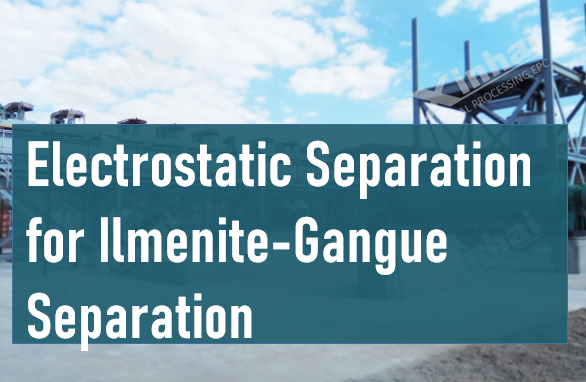Key Technology for Coarse-Grained Ilmenite Purification: Electrostatic Separation Process
2025-10-16 Xinhai (225)
2025-10-16 Xinhai (225)
If you have any questions, please contact us through the following ways, we will give you more and better assistance!

In the field of ilmenite separation, the electrostatic separation process has become an important technology for efficient separation of coarse-grained ilmenite (usually with a particle size of 0.074-0.125mm) from gangue, thanks to its advantages of low energy consumption, high purity, and low pollution. Its core principle lies in utilizing the difference in electrical properties between ilmenite and gangue minerals (such as feldspar, quartz, and mica). Ilmenite is a semiconductor mineral (conductivity > 10Ωm), while gangue is mostly non-conductive mineral (conductivity < 10Ωm). Minerals are charged through friction, induction, or corona discharge, and precise separation is achieved in an electric field. It is particularly suitable for the purification of coarse concentrates after gravity separation or magnetic separation, helping to obtain high-grade ilmenite concentrates.
The core of the electrostatic separation process lies in "parameter optimization" and "pretreatment adaptation". Firstly, it is necessary to control the feed particle size. Uneven particle size easily leads to a decline in separation accuracy, so pre-classification is usually required to ensure the feed particle size is concentrated in the range of 0.074-0.125mm. Secondly, key operating parameters need to be optimized: excessive separation voltage will cause misselection of gangue, while too low voltage will reduce the ilmenite recovery rate, with 20 kV generally being the optimal range; the feed rate must match the electric field strength—too fast will result in insufficient mineral separation, and too slow will affect processing efficiency, usually controlled at around 4.7 g/s; the air volume needs to be adjusted to 80 m³/h, which can not only carry away non-conductive gangue but also prevent conductive ilmenite from being disturbed by the air flow. In addition, if the coarse concentrate contains sulfide minerals, flotation desulfurization must be carried out first to avoid impurities affecting the electrostatic separation effect.

In practical applications, the electrostatic separation process is often combined with gravity separation and magnetic separation to form a combined flow. For example, after pre-enrichment of coarse-grained ilmenite by gravity separation, electrostatic separation can further remove gangue, increasing the TiO₂ grade of ilmenite concentrate to more than 48%; for ilmenite coarse concentrate with high silicon content, electrostatic separation can effectively reduce the SiO₂ content to less than 1%, meeting the industrial titanium standard. At the same time, the electrostatic separation process does not require a large number of chemical reagents, only consumes electrical energy, with an energy consumption of less than 5 kWh per ton of ore processed, and no wastewater discharge, which is in line with the green mineral processing trend.
In the future, ilmenite electrostatic separation technology will move towards "intelligence" and "equipment upgrading". By introducing online particle size analyzers and automatic electric field strength adjustment systems, it can adapt to changes in ore properties in real time and improve separation stability; the development of new high-gradient electric field electrostatic separation equipment is expected to break through the bottleneck of separating fine-grained (<0.074mm) ilmenite, further expand the application range of the electrostatic separation process, and provide a better solution for efficient recovery of titanium resources.